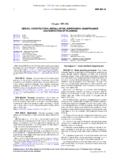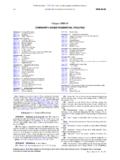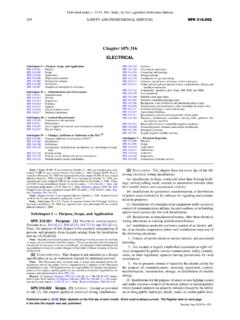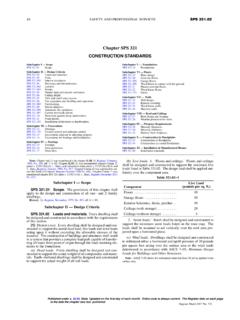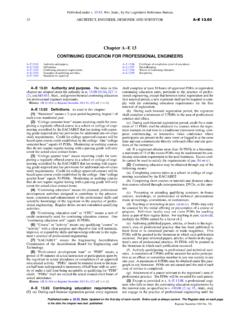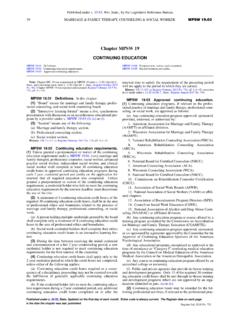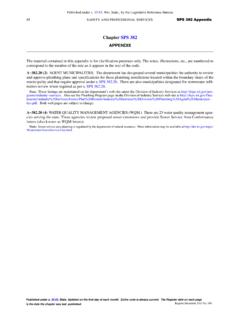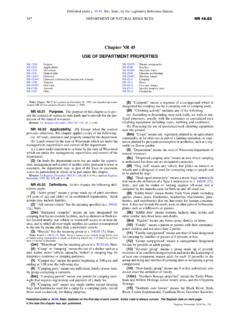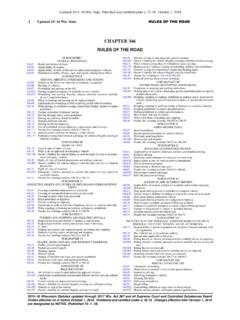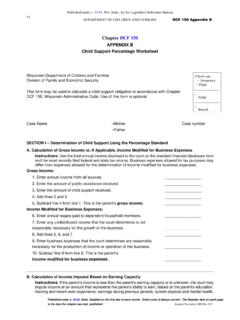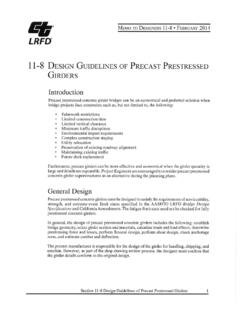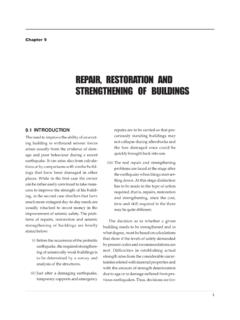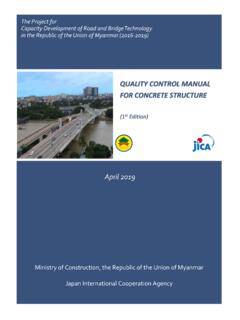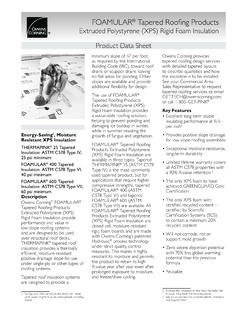Transcription of SECTION 1: GENERAL REQUIREMENTS 1.
1 Published under s. , Wis. Stats., by the Legislative Reference Bureau. 233 SAFETY AND PROFESSIONAL SERVICES SPS 320 to 325 Appendix B. Chapters SPS 320 to 325. APPENDIX B. SECTION Page SECTION Page 1 GENERAL REQUIREMENTS .. 233 9 LEDGER BOARD FASTENERS .. 243. 2 FOOTINGS, AND POST CONNECTIONS .. 234 10 FREE STANDING DECKS .. 245. 3 POSTS AND POST TO BEAM CONNECTIONS 236 11 LATERAL SUPPORT .. 246. 4 BEAMS .. 237 12 DECKING .. 248. 5 JOISTS .. 238 13 GUARD AND POSTS .. 248. 6 JOIST TO BEAM CONNECTIONS .. 240 14 STAIRS .. 250. 7 JOIST HANGERS .. 240 15 FRAMING PLAN .. 254. 8 LEDGER ATTACHMENTS .. 241. SECTION 1: GENERAL REQUIREMENTS .
2 1. All lumber, including for decking, must be pressure preservative treated and must be either douglas fir/larch, hemlock/fir, spruce/pine/fir (SPF), or southern pine, of grade #2 or better unless a naturally durable species such as a western red cedar is used. Lumber in contact with the ground must be rated as ground contact. The lumber must be identified by the grade mark of, or certificate of inspection issued by, a professional lumber grading or inspection bureau or agency ( ). Note: Not all treated lumber is rated for ground contact. See Table C 1 in Appendix C for further information. 2. Wood plastic composites must bear a label indicating their performance criteria and compliance with ASTM.
3 D7032. Published under s. , Stats. Updated on the first day of each month. Entire code is always current. The Register date on each page is the date the chapter was last published. Register December 2015 No. 720. Published under s. , Wis. Stats., by the Legislative Reference Bureau. SPS 320 to 325 Appendix B WISCONSIN ADMINISTRATIVE CODE 234. Note: Wood plastic composites are materials composed of wood fibers or powder that is bound with plastic and used typically as decking and elements of a guard or handrail. Note: When using a wood plastic composite, exercise caution as some composite members do not have the same capabilities as their equivalent wood sizes.
4 3. Nails must be threaded, which includes ring shanked (annular grooved) and spiral grooved. Note: A 1/8 inch pilot hole is recommended for all toe nailing locations. 4. All fasteners must be galvanized steel, stainless steel, or approved for use with preservative treated lumber. 5. Throughout this document, 1/2 inch diameter bolts and lag screws are specified for various connections. Edge dis- tance and spacing REQUIREMENTS are based on 1/2 inch diameter fasteners. If larger (or smaller) fasteners are speci- fied, edge distance and spacing need to be adjusted. 6. Carriage bolts may be substituted where through bolts are specified, if carriage bolt washers are installed at the bolt head.
5 Note: Carriage bolt washers have square holes. 7. Hardware, including joist hangers or post anchors, must be galvanized steel with ounces of zinc per square foot (G 185 coating), or stainless steel. All fasteners that are used with any hardware must be the same material as the hardware. All hardware must be installed in accordance with any instructions from the manufacturer. Note: For galvanized steel, look for product lines such as Zmax, Triple Zinc, or Gold Coat.. Note: Galvanized steel is not compatible with stainless steel, which can result in rapid corrosion and structural failure. Note: Hardware and fasteners that are beneath a hot tub which uses salt water disinfection should be stainless steel, grade 304 or 316.
6 8. Every deck must have an electrical outlet along the perimeter of the deck and within feet of the floor in accord- ance with NEC SECTION (E)(3). See ch. SPS 316 of the Wisconsin Administrative Code for REQUIREMENTS about installing electrical wiring. 9. A deck constructed in accordance with these standards is not approved for concentrated loads that exceed 40. pounds per square foot (psf), such as from privacy screens, planters, built in seating, hot tubs, stairs for multiple . level decks, or from snow drift loads or sliding snow loads. Engineering analysis is needed for these loads. Note: See Appendix C for features of a deck which are somewhat uncommon or which have more complexity than is addressed in this Appendix such as design values for joists consisting of western cedar or red pine, framing details around chimneys and bay windows, or ledger boards for metal plate connected wood floor trusses.
7 Appendix C also includes reference material, such as more detailed specifications for fasteners. 10. Specifications for fasteners and hardware. All nails must meet the REQUIREMENTS of ASTM F1667. Wood screws must meet the REQUIREMENTS of ANSI/ASME Bolts and lag screws must meet the REQUIREMENTS of ANSI/. ASME Fasteners to be hot dipped galvanized must meet the REQUIREMENTS of ASTM A153, Standard Specification for Zinc Coating (Hot Dip) on Iron and Steel Hardware, Class D for fasteners 3/8 diameter and smaller or Class C for fasteners with diameters over 3/8 . Fasteners other than nails and timber rivets may consist of mechanically deposited zinc coated steel with coat- ing weights in accordance with ASTM B695, Class 55, minimum.
8 Hardware to be hot dipped prior to fabrication must meet ASTM A653, Standard Specification for Steel Sheet, Zinc Coated (Galvanized) or Zinc Iron Alloy Coated (Galvannealed) by the Hot Dip Process, G 185 coating. Hardware to be hot dipped galvanized after fabrication must meet ASTM A123, Specification for Zinc (Hot Dip Galvanized) Coatings on Iron and Steel Products. 11. Safety glazing at decks shall be in accordance with the safety glazing REQUIREMENTS of the Uniform Dwelling Code (UDC). SECTION 2: FOOTINGS, AND POST CONNECTIONS. Footings must comply with all of the following: 1. Concrete must be used and must have a minimum compressive strength of 3,000 pounds per square inch.
9 Published under s. , Stats. Updated on the first day of each month. Entire code is always current. The Register date on each Register December 2015 No. 720 page is the date the chapter was last published. Published under s. , Wis. Stats., by the Legislative Reference Bureau. 235 SAFETY AND PROFESSIONAL SERVICES SPS 320 to 325 Appendix B. 2. Footing size and thickness must be in accordance with Table 1. (See sections 4 and 5 for determining post spacing and joist length.). 3. Post attachments must be in accordance with Figure 1 except expansion anchors are also permitted and any instructions from the manufacturer of the anchor must be followed.
10 4. Post anchors must include a 1 inch minimum base plate. Steel plates are not required. 5. Each post must bear directly over the middle one third of a footing. 6. Footings must bear on solid ground below the frost penetration level or at least 48 inches below finished grade, whichever is deeper. Bearing onto unprepared fill material, organic soil, alluvial soil, or mud is prohib- ited. The bearing capacity of the soil is presumed to be at least 2000 pounds per square foot (psf), and must be verified by a building inspector prior to placement of concrete. 7. If the edge of a deck footing is closer than 5 feet to an existing house wall, the footing must bear at the same elevation as the existing footing for that wall.
